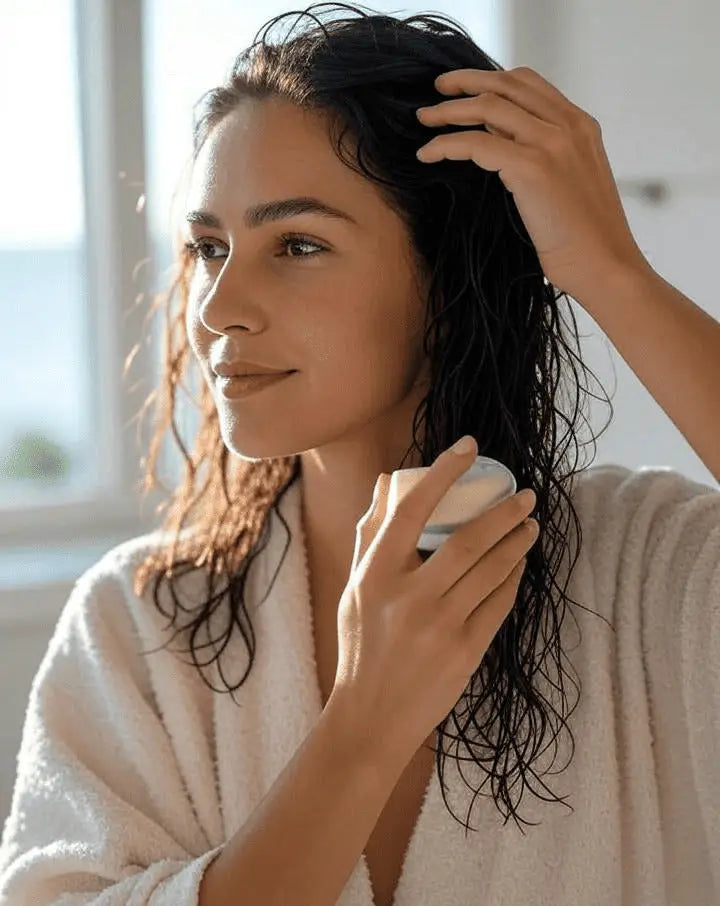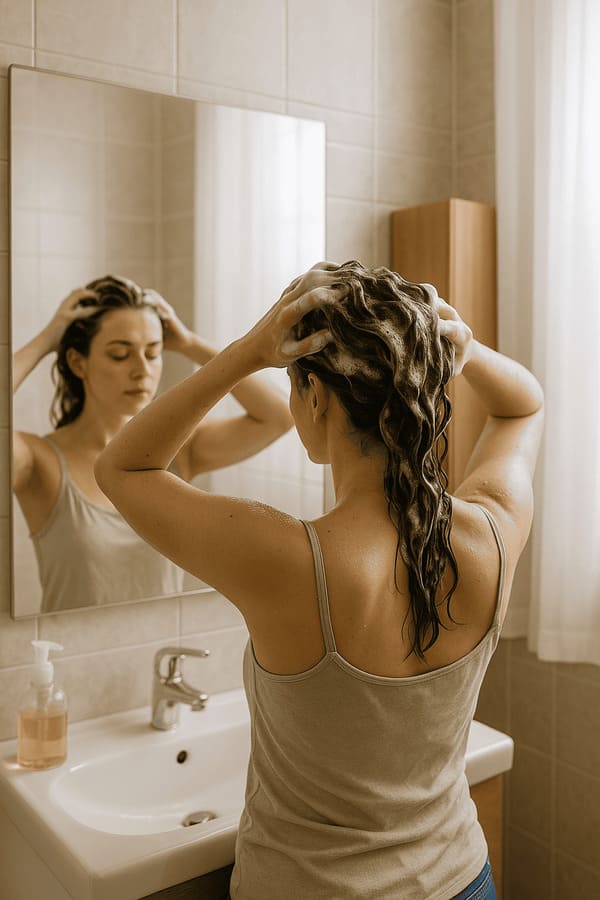Introduction
Conditioner isn't an optional step, but a fundamental step for healthy hair. It's the product that transforms dull, unmanageable hair into visibly healthy, soft, shiny, and easy-to-comb locks.
After shampooing, the hair cuticles remain open, making the fiber more vulnerable. Conditioner helps: it closes the cuticles, reduces static electricity, and improves detangling, without necessarily weighing down the hair.
In this guide, we'll look simply and practically at how it works, what types exist, how to choose the right product for you, and what mistakes to avoid.
A little spoiler: it's not the quantity that makes the difference, but consistency and the right conditioner.
What is conditioner and how does it work (explained simply)
Conditioner is a conditioning treatment that restores hair's balance after cleansing. Its effectiveness is due to a combination of key ingredients:
- Cationic conditioners (e.g. Behentrimonium Methosulfate): have a positive charge and bind to the hair fiber (negative charge), smoothing the surface and reducing knots.
- Humectants (e.g. Glycerin, Aloe, Panthenol): attract and retain water, keeping hair hydrated.
- Emollients (e.g. light oils, shea butter): create a protective film on the lengths, protecting them from external agents.
- Slightly acidic pH : essential for closing the cuticles, sealing in hydration and increasing shine.
👉 The result? Hair that's instantly softer, shinier, easier to manage, and protected from mechanical damage from brushing and styling.
Types of conditioner: to each his own
- Classic rinse-out conditioner : the most common, versatile, and detangling. Leave on for 1-3 minutes (up to 5 for thick or curly hair).
- Leave-in conditioner (no rinsing) : light and practical, perfect for curls, dry ends or to revive the style between washes.
- Cleansing conditioner (co-wash) : contains gentle surfactants and conditioning agents. Ideal for frequent washing or for those with sensitive skin.
- Detangling spray or milk : very light, perfect for eliminating knots in the morning or when you're worried about weighing your hair down too much.
- Solid conditioner : an eco-friendly, compact, zero-waste alternative. Rub it into wet hair or between your hands, then rinse.
If your hair needs more nourishment, alternate classic conditioner with a specific mask 1-2 times a week for an intensive treatment.
How to Choose the Right Conditioner for You: The Ultimate Guide
Learning to recognize your hair's needs is the first step to finding the right product.
For fine or heavy hair
- Ideal Texture: Light, fluid or milky.
- Key Ingredients: Look for Panthenol, Lightweight Hydrolyzed Proteins (Rice, Wheat), and gentle conditioners.
- Avoid: Formulas too rich in heavy oils, butters, waxes or silicones.
- Recommended Use: Apply only from mid-lengths to ends and allow a few extra seconds to rinse. You can alternate a light conditioner with a detangling spray for a weightless effect.
For Dry, Curly or Wavy Hair
- Ideal Texture: Rich, creamy and with high detangling power.
- Key Ingredients: Glycerin, Aloe, Panthenol, Shea Butter, and Oils (such as Avocado or Coconut). An acidic pH is a major advantage.
- Recommended Use: Excellent as a base for styling methods for curly hair (e.g., LOC/Curly). If your curls tend to lose definition, try leaving a light layer of product on the ends without rinsing completely.
For greasy hair (or roots that get dirty quickly)
- Ideal Texture: Light and balanced.
- Key Ingredients: Panthenol and light proteins. Oil content should be minimal or absent.
- Recommended Use: Apply only to lengths and ends. For very frequent washing, consider alternating the shampoo with a co-wash to avoid stressing the scalp.
For Colored or Treated Hair
- Goal: Seal cuticles to protect color and repair structural damage.
- Key Ingredients: Hydrolyzed Proteins (Vegetable Keratin, Rice Protein), Ceramide-like and antioxidants such as Vitamin E.
- Recommended Use: Leave on for longer, 3 to 5 minutes, and always rinse with warm (never hot) water to avoid fading the color.
SOS Hair: Common Mistakes and Solutions
Even with the right product, application makes the difference.
-
The Mistake: Applying it to your scalp.
The Problem: It can weigh down the roots and, in some cases, irritate the scalp.
The Solution: Always start 3-4 cm away from the root and distribute it towards the ends. -
The Mistake: Using too much.
The Problem: Leads to a flat effect and hair that looks dirty before its time.
The Solution: Start with a walnut-sized amount. Add more if needed. Often, a longer soak time is more effective than an excessive dose. -
The Mistake: A hasty rinse.
The Problem: Residue leaves hair dull and can weigh it down.
The Solution: Spend at least 30-40 seconds rinsing, making sure the water runs cleanly through all of your strands.
What is the best hair conditioner?
There's no single best conditioner, but rather the one best suited to your hair type. Light for fine hair, rich for curly or dry hair, balancing for oily hair, protective for color-treated hair.
What can I use instead of hair conditioner?
If you don't have conditioner, you can use aloe vera, an acid rinse, or a light oil compress. These are temporary solutions; for lasting results, you'll need a specific conditioner.
What is the difference between a conditioner and a mask?
The conditioner is quick and acts on the surface. The mask is intensive and penetrates deeper, to be used weekly.
What conditioner should I use for oily hair?
Lightweight, oil-free formulas, applied only to the lengths. Alternating conditioner and co-wash is a great option.
What happens if you don't rinse out the conditioner well?
Residues make hair dull, heavy, and dirty more quickly. The exception is leave-in products, which are designed not to be rinsed out.
How do you use solid conditioner?
Rub it onto wet hair or between your hands, let it soak in, and rinse well. It's practical and sustainable.
Ready to Choose Your Ideal Product?
As you've seen, conditioner is much more than just a detangler. It's an essential treatment that protects, moisturizes, and improves the appearance of your hair with every wash.
Now you have all the tools to make an informed choice. Explore our complete selection of conditioners on Yumibio and find the perfect formula for your hair's needs.
Discover the complete section dedicated to hair routines
















































































